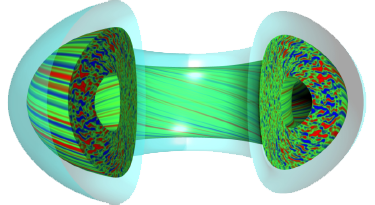Speaker
Description
The TGLF model is a quasi-linear model of transport driven by gyrokinetic turbulence. A reduced velocity space moment linear eigensolver is used, which is calibrated to first principles linear calculations. The saturation rule for the intensity of the fluctuations is fit to 3D spectra of nonlinear gyrokinetic simulations with the CGYRO code. TGLF is never fit to experiment so that it can be used to test the gyrokinetic theory over large datasets and predict plasma profiles with a transport code. A new approach to testing TGLF flux predictions (not plasma profile predictions) with a very large database of DIII-D discharges, which have been curated to remove cases where gyrokinetic transport should not apply, has been completed. This database contains experimental profiles and power balance analyses, and was generated using automated workflows within the Python based data analysis suite OMFIT. A novel way to identify the experimental input parameters that are associated with the largest differences between TGLF energy fluxes and experimental power balance fluxes will be reported here. This identification will help direct the choice of nonlinear gyrokinetic turbulence simulations to perform with the CGYRO code to improve the fidelity of TGLF to CGYRO or to confirm disagreement of gyrokinetics with experiment. As a first step, the TGLF model for the intensity spectrum is multiplied with a hypothetical correction factor that is sensitive to the overall shape of the intensity spectrum and computed by a neural network trained on the experimental database. Symbolic regression tools find the main elements of this correction factor. This process resulted in a power law form with plasma parameters that typically are associated with trapped electron mode turbulence. These identified plasma parameters will be used to direct new CGYRO gyrokinetic database simulations to efficiently cover the least accurately covered operational space of present and future devices.
| Country or International Organisation | United States of America |
|---|---|
| Affiliation | General Atomics |

